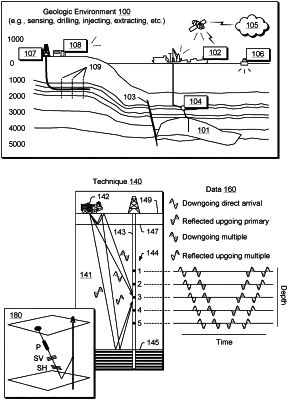| CPC G01V 1/288 (2013.01) [G01V 1/282 (2013.01); G01V 1/42 (2013.01); G01V 2210/1234 (2013.01)] | 19 Claims |

|
1. A method comprising:
receiving a velocity model derived via compressional (P) wave signals versus depth in a geologic environment that comprises an anisotropic formation comprising one or more subsurface layers;
receiving compressional (P) wave signals and shear (S) wave signals that span a depth range of the anisotropic formation, wherein the compressional (P) wave signals and the shear (S) wave signals are generated using a first controlled electric source disposed in a first kickoff portion of a first well and a second controlled electric source disposed in a first toe portion of the first well, wherein the first well is drilled from a surface layer into the anisotropic formation to form a first bore, wherein the first bore comprises the first kickoff portion spanned from the surface layer to the anisotropic formation and connected to the first toe portion spanned along the one or more subsurface layers via a first heel portion, and wherein the compressional (P) wave signals and the shear (S) wave signals are acquired via a first receiver array disposed in a second toe portion and a second receiver array disposed in a second heel portion and a second kickoff portion of a second well, wherein the second well is drilled from the surface layer into the anisotropic formation to form a second bore, wherein the second bore comprises the second kickoff portion spanned from the surface layer to the anisotropic formation and connected to the second toe portion spanned along the one or more subsurface layers via the second heel portion;
calibrating vertical and horizontal velocities of the velocity model using the compressional (P) wave signals and the shear (S) wave signals generated by the first controlled electric source and the second controlled electric source;
generating a crosswell calibrated velocity model based on the calibrated vertical and horizontal velocities;
receiving first seismic data responsive to a first stage of stimulation of the anisotropic formation via a first perforation in the first toe portion of the first well disposed in the anisotropic formation, wherein the first seismic data comprise seismic data received by the receiver array;
revising information stored in a look-up table based at least in part on the first seismic data; locating a first microseismic event generated by the first stage of stimulation using at least a portion of the received first seismic data, the revised information, and the crosswell calibrated velocity model, wherein the crosswell calibrated velocity model is generated without using the first seismic data generated by the first perforation;
rendering the located first microseismic event generated by the first stage of stimulation with respect to one or more dimensions of the anisotropic formation via a display;
adjusting one or more parameters of a second stage of stimulation of the anisotropic formation based at least in part on the first microseismic event;
receiving second seismic data responsive to the second stage of stimulation of the anisotropic formation via a second perforation in the first toe portion of the first well disposed in the anisotropic formation, wherein the second seismic data comprise seismic data received by the receiver array;
locating a second microseismic event generated by the second stage of stimulation using at least a portion of the received second seismic data and using the crosswell calibrated velocity model, wherein the crosswell calibrated velocity model is generated without using the second seismic data generated by the second perforation; and rendering the second microseismic event generated by the second stage of stimulation with respect to the one or more dimensions of the anisotropic formation via the display, and transmitting information from the first microseismic event and second microseismic event to control, adjust, or initiate one or more operations of equipment associated with the geologic environment.
|